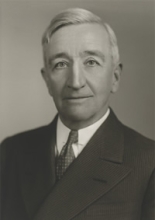Harry W. Blair

Early History/ Schooling: Harry W. Blair was born in Marysville, Missouri and attended high school in Carthage, Missouri. After graduating from Columbian Law School (now George Washington University) in 1904, he returned to Joplin, Missouri.
Tenure as AAG: In June 1933, George C. Sweeney was nominated to be AAG of the Lands Division, but was transferred to be AAG of the Claims Division during a December 1933 reorganization of the Justice Department. Blair, a special assistant to the Attorney General, was then nominated to head the Lands Division.
During Blair’s tenure, the Division was handling over one hundred cases with claims totaling over $3 billion by Indian Tribes against the United States. The Tribes argued that their lands had been taken away without any, or sufficient, payment, or that money received in payment had not been used for the Tribes’ benefit, or that the United States did not provide the lands or materials promised in various treaties. Many of these cases involved counterclaims by the United States arguing that it had, in some cases, supplied more than what was promised the Tribes by treaty. As a result of these cases, legislation was introduced in Congress in 1935 to create an Indian Claims Commission. The Commission was eventually established in 1946. The Division also sued oil companies on behalf of Tribes to recover monies due to them.
Blair also was involved in a dispute over whether the federal government could enjoin the building of a dam under the Rivers and Harbors Act of 1899 on the New River in Virginia, a case that eventually made its way to the Supreme Court. Blair also appears to have been involved in the defense of the constitutionality of New Deal legislation. The Division grew substantially in numbers of attorneys and staff under Blair’s tenure – by some accounts from 59 persons to 759 persons – in part due to a reorganization within the Justice Department.
Career: While attending law school, Blair worked as a secretary for Secretary of Labor and Commerce George B. Courtelyou, and had frequent interactions with other notable members of President Theodore Roosevelt’s cabinet, including Gifford Pinchot of the Department of Agriculture’s Forestry Division. During this time, he investigated the General Slocum steamer ship disaster of 1904, in which over 1000 people lost their lives in the East River, New York. During WWI, Blair served in France (he is variously reported as serving with the Red Cross, the Salvation Army, and the YMCA), and then returned with his family to his hometown of Carthage, Missouri. From 1919 to 1933, he practiced law in Joplin, Missouri. He was named special assistant to the Attorney General in 1933, and soon thereafter became Assistant Attorney General.
After his tenure as AAG, he served as a special assistant to the Attorney General for several years, and then went into private practice in Washington, D.C. with his son, Newell Blair. From 1947 until 1950, Mr. Blair served on a Regional Loyalty Board, and from 1950-53 served on the President’s Loyalty Review Board, which reviewed federal agency loyalty board determinations regarding whether federal workers were pro-Communist. Mr. Blair retired in 1962.
Personal: Blair married Emily Newell, his former high school classmate, in 1900, and the couple had two children: Newell Blair, a Washington lawyer and businessman who founded three legal newsletters, and a daughter whose married name was Mrs. N.M. Forsythe. Mrs. Blair was perhaps more well-known than her husband, and was likely at least partially responsible for his government career. She was a political activist, suffragist, and writer, and a co-founder of the League of Women Voters. She served as the Vice Chair of the Democratic Party in 1922, and later in Franklin Roosevelt’s 1932 Presidential campaign. She served as an editor of Good Housekeeping magazine from 1925 to 1934. In the 1940s, the Washington Post regularly covered the Blairs’ parties, which often included Washington’s elite.
One biographer of Emily Newell Blair described her involvement in her husband’s appointment to government service: “Since late summer 1932, [Emily Newell Blair] had made it clear to many of her colleagues that she hoped her reward for a successful campaign would be a job for Harry. . . . The Blairs’ hopes for a suitable appointment rose when Roosevelt’s initial appointment to Attorney General, Sen. Thomas J. Walsh of Montana, died on March 2, 1933, en route to Washington. Roosevelt then named . . . Homer Cummings to lead the Justice Department. It seemed a particularly favorable choice for the Blairs. With their expectations high, it was a particularly hard blow when Cummings appointed Harry Blair, not to head the Lands Division, but only as one of several lawyers within that Division. . . . A still heavier blow came when Mary (a friend of the Blairs) described her conversation with Cummings, who admired Harry as a lawyer but did not think he was a ‘leader of men.’” Additionally, Cummings, in reference to Emily, “spoke of his regard for you, and said that if you were the lawyer, you would [have] the qualifications to take charge of a department.” However, “By the end of that year (1933), Harry proved himself to Attorney General Cummings and was rewarded by appointment to the position that he and Emily had thought him originally entitled, Assistant Attorney General.” Blair, Emily Newell and Lass, Virginia Jean. Bridging Two Eras: The Autobiography of Emily Newell Blair, 1877-1951. Columbia: University of Missouri Press, 1999.
Blair died in 1964.
This material is based on the review of a variety of historical sources, and its accuracy cannot be guaranteed. If you have any corrections or additional information about this individual or about the history of the Division, please contact ENRD.

 U.S. Department
of Justice
U.S. Department
of Justice